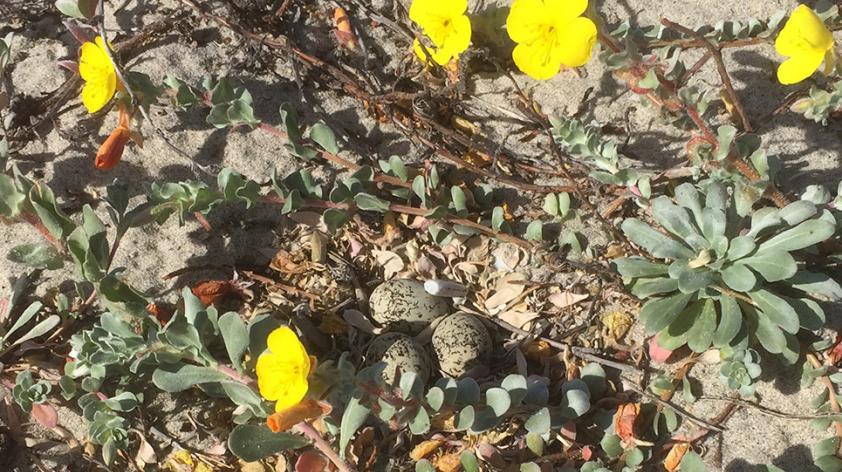
Plovers Protecting Their Progeny
A western snowy plover nest is a simple scrape in the sand. Can you spot the eggs in this nest? Photo by Travis Wooten, SDZG on MCB Camp Pendleton
As the early morning sun begins to warm the sandy beaches at Marine Corps Base Camp Pendleton, the Tern and Plover Crew is ready to begin a day in the field. The seven of us spend each day monitoring the beach nesting habitat that endangered California least terns and western snowy plovers utilize on the Marine Corps base. Most of the day is spent carefully searching the sandy beaches for nests, which look like a small scrape in the sand, containing sandy-colored speckled eggs. Sometimes the western snowy plovers line their nest cups with bits of shell or dried leaves, but many tern and plover nests are simply an indentation in the sand with many small tracks leading up to it. Their cryptically patterned eggs are only one way in which they hide their nests from predators; these small birds wouldn’t win in a fight against a predator, so they have other strategies to help protect their nests. As we survey and check nests, we see firsthand the behaviors the birds use to defend their nests. Even though we are working to help protect these threatened and endangered birds, we still look like big, scary predators to them! Western snowy plovers generally lay claim to a nesting territory away from other plover nests and make their nests in a sandy spot on the beach where they have a good view of their surroundings. When a pair nests, the male and female share egg incubation duties until the chicks hatch—then the males take care of the young until they are able to fly. After the eggs hatch and if it is still early in the breeding season, a female will often go find another male and create a new nest with him. Plover chicks are precocial, meaning that they walk and can find food on their own soon after hatching—but there’s still a role for the father! Males tend to their chicks by guiding them to good food sources and brooding them, which protects them from the elements. They also defend their chicks from any perceived threats.
This male plover is doing his best to distract the researchers away from his offspring. Photo by Emily Rice, SDZG on MCB Camp Pendleton
Whether it is a nest of eggs or a brood of chicks, the western snowy plover has a few strategies to protect and defend their offspring. These small, quiet plovers are not threatening to a predator, but they definitely can be distracting! If a predator gets too close, the adult plover will feign a broken wing or injury to entice the predator to follow them away from the nest or chicks. Predatory animals will often target injured or weak prey because it is easier to capture, so the plovers’ tactic of feigning an injury can trick a predator to go after the adult instead of finding the eggs or young. During our surveys in the field, when we get close to a plover nest or chicks in the field we usually hear a few chirps from the adult and observe them attempting to lead us away while dragging wings or tail on the ground. Once the threat has left the area, the female plover will sneak back to her nest to continue incubation or, in the case of chicks, the male will call to his hiding offspring and resume watching over them as they run to chase down sand fleas and other yummy food. It’s great to see that these small, unintimidating bird species have ways to protect their eggs and young from threats. If you are walking on the beach and see a plover acting injured you’ll know you are probably too close to their nest or brood. The best thing to do is to keep a safe distance away so they don’t need to spend more energy on you and can go back to incubating their eggs or tending their young. Sharing the beach with endangered wildlife is a great privilege and responsibility, and it takes all of us to help protect these sensitive species. Jennifer Hahn is a research associate with the San Diego Zoo Institute for Conservation Research. Learn more about the least tern and snowy plover project here.













